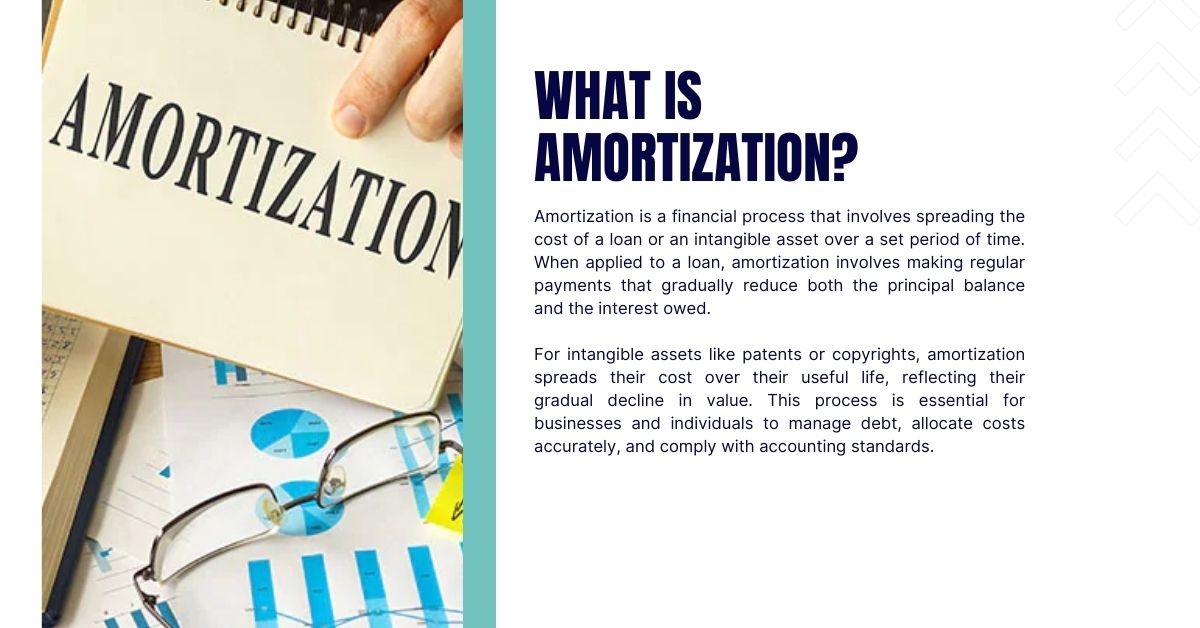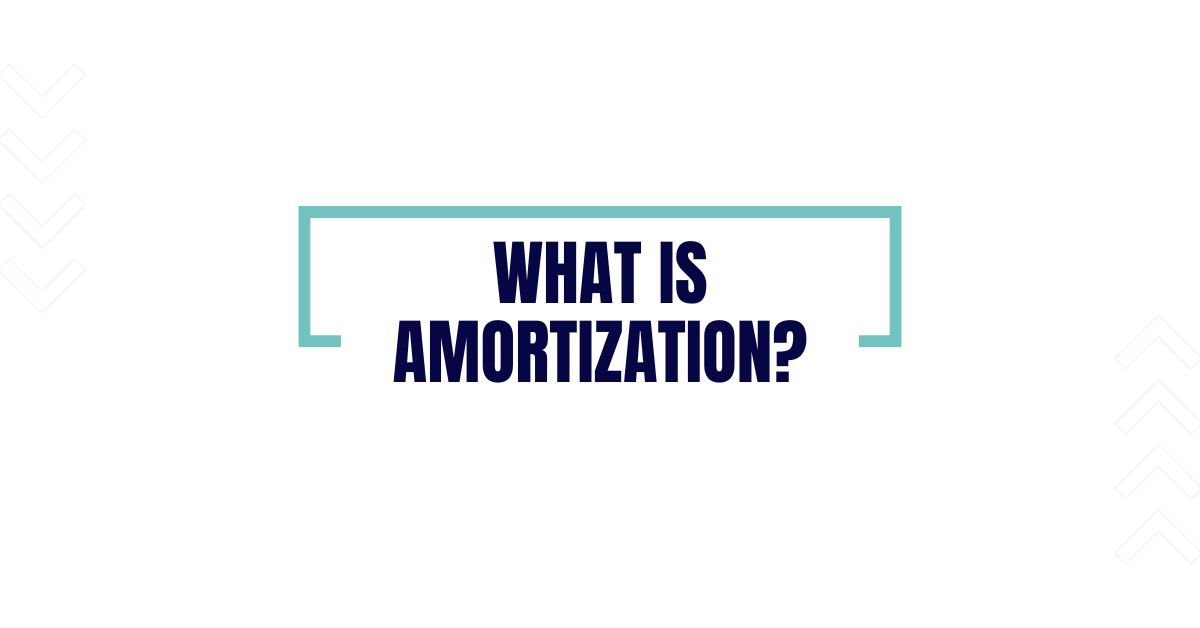Let us say you just bought a new car and borrowed money to pay for it. With each monthly payment, you’re not only paying interest on the loan but also cutting up away at the principal balance. This gradual reduction of the loan balance is known as amortization. In this post, we’ll uncover the mechanics behind this process and its significance in various financial contexts.
What is Amortization?

Amortization is a financial process that involves spreading the cost of a loan or an intangible asset over a set period of time. When applied to a loan, amortization involves making regular payments that gradually reduce both the principal balance and the interest owed.
For intangible assets like patents or copyrights, amortization spreads their cost over their useful life, reflecting their gradual decline in value. This process is essential for businesses and individuals to manage debt, allocate costs accurately, and comply with accounting standards.
How to Calculate Amortization?
A formula is used to figure out the amount of monthly payments that are needed to pay off a loan over a certain time. The formula considers the principal amount borrowed, the interest rate, and the number of payment periods.
The formula for calculating the periodic payment amount is:
A = [P * (r/n) * (1 + r/n)^nt] / [(1 + r/n)^nt – 1]
where:
- A = Periodic payment amount
- P = Principal amount
- r = Annual interest rate (expressed as a decimal)
- n = Number of payment periods per year
- t = Total number of years for the loan
This formula can be used to calculate the monthly payment for a mortgage, car loan, or any other loan that is amortized over time.
How Amortization Works?
Amortization is the process of spreading the cost of a loan or an intangible asset over a set period. For loans, each payment typically includes both interest and principal. Initially, a larger portion goes towards interest, but this gradually decreases as the principal balance reduces.
For intangible assets, amortization allocates a portion of their cost to each accounting period, reflecting their gradual decline in value. This systematic approach helps businesses and individuals manage debt, plan for future expenses, and comply with accounting standards.
What is Amortization of an Asset?
Amortization of an asset is the process of systematically allocating the cost of an intangible asset over its useful life. Intangible assets, such as patents, copyrights, or goodwill, lack physical substance but still provide economic value to a company.
Amortization helps match the expense of using these assets with the revenue they generate over time, providing a more accurate reflection of a company’s profitability.
What is Amortization of a Loan?
Amortization of a loan is the process of spreading out loan payments over a set period of time. The payments typically include both interest and principal, with the proportion of each changing over time. Initially, a larger portion goes towards interest, but this gradually decreases as the principal balance reduces. This structured approach helps borrowers manage their debt and ensures that the loan is repaid in full by the agreed-upon date.
Why is It Useful to Understand Amortization?
Understanding amortization is crucial for both individuals and businesses for several reasons. For individuals, it helps in managing debt effectively by providing a clear picture of how loan payments are structured and how much of each payment goes towards principal versus interest.
This knowledge empowers borrowers to make informed decisions about loan terms and repayment strategies. For businesses, amortization is essential for accurate financial reporting and tax planning. By understanding how the cost of intangible assets is allocated over time, businesses can make informed decisions about investments and ensure compliance with accounting standards.
Common Methods of Amortization
The most common methods of amortization are:
- Straight-line method: In this simple method, the cost of the object is spread out evenly over the time it will be useful.
- Declining balance method: This method allocates a larger portion of the cost to the earlier years of the asset’s life.
- Units-of-production method: This method allocates the cost based on the actual usage of the asset.
The specific method chosen depends on the nature of the asset and the company’s accounting policies.
If you want to learn about depreciation, you can read here: Depreciation: The Silent Cost of Doing Business
Is Amortization an Expense?
Yes, amortization is considered an expense. When used on intangible assets, amortization spreads the cost of the object out over the time it can be used. This allocation is treated as an expense on the income statement, reducing the company’s reported profits. While amortization doesn’t involve a direct cash outflow, it reflects the gradual consumption of the asset’s value over time.
Impact of Amortization on Financial Decisions
Amortization significantly impacts financial decisions in several ways:
- Loan Repayment Strategies: Understanding amortization schedules helps borrowers make informed decisions about loan terms, interest rates, and repayment strategies. By analyzing how much of each payment goes towards principal versus interest, borrowers can optimize their repayment plans to minimize overall interest costs.
- Investment Decisions: For businesses, amortization of intangible assets affects investment decisions. By understanding how the cost of these assets is allocated over time, companies can assess the profitability of investments and make informed choices about acquiring or developing new intangible assets.
- Financial Reporting and Analysis: Amortization is crucial for accurate financial reporting and analysis. It affects key financial metrics such as earnings per share and return on assets. By understanding the impact of amortization on these metrics, investors and analysts can gain a more accurate picture of a company’s financial performance.
- Tax Planning: Amortization expenses can be used to reduce taxable income, which can have a significant impact on a company’s tax liability. By understanding the tax implications of different amortization methods, businesses can optimize their tax strategies.
Overall, understanding amortization is essential for making sound financial decisions, whether it’s managing personal debt, investing in assets, or running a business.
What is Negative Amortization?
Negative amortization occurs when the payments made on a loan are insufficient to cover the interest accrued during that period. This results in the unpaid interest being added to the principal balance of the loan, causing it to increase over time rather than decrease.
This situation typically arises in loans with adjustable interest rates or in certain types of mortgage loans where borrowers are allowed to make smaller initial payments. While it can provide short-term affordability, negative amortization can lead to significant long-term debt burdens and potential financial difficulties.

